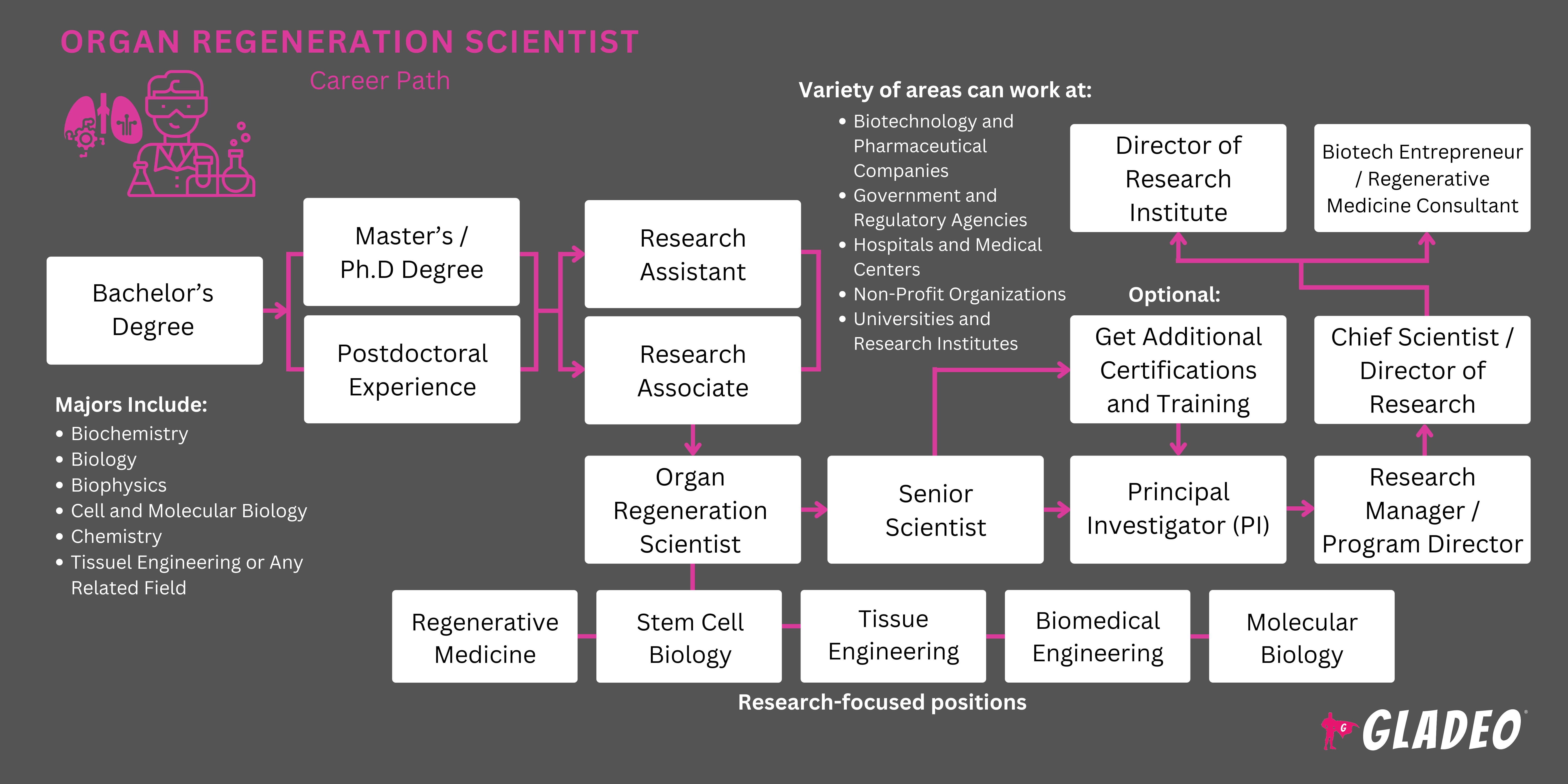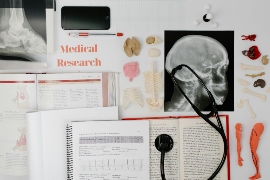Spotlights
Tissue Regeneration Scientist, Stem Cell Researcher, Regenerative, Medicine Specialist, Biomedical Research Scientist, Organ Biology Researcher, Stem Cell Biologist, Cell and Tissue Engineer, Regenerative Biology Scientist, Organ Development Scientist, Medical Researcher (Regeneration)
The idea of regenerating organs might sound like science fiction, but Organ Regeneration Scientists are making it a reality! These professionals work at the cutting edge of regenerative medicine. As the University of Pittsburgh explains, “Regenerative medicine seeks to replace tissue or organs that have been damaged by age, disease, trauma, or congenital issues, vs. the current clinical strategy that focuses primarily on treating the symptoms.”
Organ Regeneration Scientists research methods to restore or replace damaged tissues and organs through cellular regeneration, stem cells, bioengineering, tissue engineering, and organoid development. Their work aims to develop treatments for conditions that currently require organ transplants, reducing reliance on donors and lowering the risk of organ rejection.
This revolutionary field is changing the world of healthcare by offering solutions for serious conditions like heart disease, liver failure, and kidney damage. Whether working in laboratories, biotech companies, or research hospitals, Organ Regeneration Scientists are literally reshaping the future of medicine and pushing the boundaries of human health!
- Advancing medical treatments that could eliminate the need for organ transplants
- Developing life-saving therapies for patients with severe organ damage
- Contributing to groundbreaking research in regenerative medicine
- Working in interdisciplinary teams
Working Schedule
Organ Regeneration Scientists work full-time in research labs, biotech companies, universities, and medical centers. Their schedules may include extra hours when conducting experiments, analyzing data, or preparing research for publication.
Typical Duties
The field of organ regeneration includes multiple specializations, each focused on different aspects of tissue repair and replacement. Here’s how the work breaks down:
Stem Cell Biologist – Studies stem cells’ role in regenerating damaged tissues and organs. Works in academic and clinical research settings.
- Researches stem cell differentiation and reprogramming to develop regenerative therapies.
- Investigates how stem cells interact with damaged tissues and contribute to healing.
- Develops techniques to generate patient-specific cells for organ repair.
- Studies the ethical and regulatory aspects of stem cell-based treatments.
Tissue Engineer – Specializes in creating artificial tissues and organs using biomaterial scaffolds and tissue engineering techniques. Works in research institutions, hospitals, and biotech companies.
- Designs and fabricates biomaterial scaffolds to support cell growth and tissue formation.
- Uses 3D bioprinting to develop complex tissue structures.
- Tests engineered tissues for functionality and compatibility with human biology.
- Works with surgeons and medical teams to apply tissue-engineered products in clinical settings.
Organoid Researcher – Develops miniature organ models (organoids) to study disease, drug responses, and organ development. Works in pharmaceutical and biomedical research.
- Cultivates organoids from patient-derived stem cells to model diseases.
- Uses organoid systems to test drug therapies for effectiveness and safety.
- Studies how organs develop at a cellular level to improve regenerative medicine.
- Integrates bioinformatics and AI to analyze complex biological data.
Additional Duties
- Collaborating with medical researchers, AI researchers, computational biologists, bioengineers, and clinicians on new treatments.
- Conducting lab experiments to test regenerative therapies.
- Publishing findings in scientific journals and presenting at conferences.
- Securing grants and funding for research.
- Navigating ethical and regulatory considerations.
Soft Skills
- Analytical thinking
- Attention to detail
- Communication
- Creativity
- Curiosity
- Decision-making
- Ethical judgment
- Observant
- Patience
- Problem-solving
- Teamwork
- Time management
Technical Skills
Organ Regeneration Scientists need hard skills related to the following:
- Stem cell culture and differentiation techniques
- Tissue engineering and biomaterial science
- CRISPR (clustered interspaced short palindromic repeats) and gene-editing technologies
- 3D bioprinting for organ scaffolds
- Microscopy and imaging techniques
- Biochemical and molecular biology assays
- Computational modeling for tissue regeneration
- AI-driven drug discovery for regenerative medicine
- Biomedical research institutes
- University laboratories
- Biotech and pharmaceutical companies
- Hospitals and medical centers
- Government agencies
Organ Regeneration Scientists work in a field that requires patience, resilience, and a commitment to scientific discovery. Developing new regenerative therapies is a time-intensive process that can take years of work before reaching any sort of real-world clinical application.
Immediate results are rarely visible and setbacks are common due to the complexity of growing functional tissues and organs. Progress is made in small steps, with breakthroughs coming only after extensive trial-and-error experimentation. In addition, promising treatments can be held back due to extensive regulatory approval processes, which can be frustrating but necessary.
Work environments can be demanding, with potentially long hours in labs and extensive collaboration with multidisciplinary teams. Organ Regeneration Scientists might find themselves working alongside bioengineers, clinicians, pharmaceutical researchers, and regulatory experts, which requires them to be up-to-speed on a wide range of subjects and techniques.
Grant writing is also a sometimes tedious part of the job – but securing funding can be highly competitive, so they’ve got to take it seriously. This competition adds an extra layer of pressure, requiring scientists to balance their day-to-day work with the necessity of finding the money to pay for it all.
The field of organ regeneration is advancing at an unprecedented pace, with bioengineering innovations pushing the boundaries of what’s possible. One of the most promising developments is 3D bioprinting, which allows scientists to construct complex tissue structures layer by layer using bio-inks made of living cells.
Researchers are using this technology to develop lab-grown organs such as kidneys, livers, and hearts, with the goal of eventually transplanting them into patients. Alongside bioprinting, CRISPR gene-editing technology is enabling precise modifications of stem cells, making it possible to repair genetic defects before damaged tissues even begin to form.
These breakthroughs could dramatically reduce reliance on traditional organ transplants, offering patients customized regenerative solutions designed to match their genetic makeup!
Another trend is the use of organoid models to study diseases and test new drug therapies. Organoids are miniature, lab-grown versions of human organs that, to some extent, mimic their real-life structures and functions. Scientists use these models to understand conditions like liver disease, heart failure, and neurodegenerative disorders, so they can create better treatments. Also, since organoids can be grown from a patient’s own stem cells, they offer a platform for personalized medicine, where treatments can be tested on a patient's cells before being administered in real life.
Global collaboration and investment in regenerative medicine are driving the field forward. Governments, biotech startups, and pharmaceutical giants are pouring billions into organ regeneration initiatives, recognizing the potential of this science to revolutionize healthcare. Even space agencies like NASA are studying how microgravity impacts stem cell growth and tissue engineering, with the hope that space-based research can unlock new methods of cultivating organs.
Organ Regeneration Scientists often had a passion for biology, chemistry, and problem-solving. They might have enjoyed science fairs, experimenting with microscopes, or learning about medical advancements. Many were drawn to medical research, fascinated by genetics, and eager to make an impact in healthcare.
- A bachelor’s degree in biology, biomedical engineering, biochemistry, or a related field is the starting point for this career. However, most roles require a master’s or Ph.D. in regenerative medicine, stem cell biology, or bioengineering.
- Postdoctoral research experience is essential for those aiming for academic or high-level research positions.
- Common college courses include:
- Biochemistry
- Biology
- Biomaterials
- Biophysics
- Cell and molecular biology
- Chemistry
- Computational biology
- Genetics and gene editing
- Regenerative medicine
- Tissue engineering
- To gain hands-on experience, students should seek internships in biomedical research labs, stem cell institutes, or biotech companies. Practical training in 3D bioprinting, stem cell differentiation, and gene editing technologies is highly valuable.
- Additional certifications and training programs include:
- Stem cell biology certification (offered by universities and research institutes)
- 3D bioprinting and tissue engineering courses
- CRISPR gene editing workshops
- FDA regulatory training for biomedical research
- Look for accredited programs in biomedical engineering, stem cell research, or regenerative medicine. Find programs that feature:
- Access to research labs with advanced bioprinting and tissue engineering technology,
- Opportunities for clinical collaboration with hospitals, and,
- Faculty members conducting research in organ regeneration and bioengineering.
- Check out faculty bios to learn about their expertise and current research.
- Review scholarships, financial aid, and research funding opportunities.
- Compare tuition and fees, including in-state vs. out-of-state costs.
Organ Regeneration Scientists can start their search for suitable programs by checking out college program rankings such as Niche’s 2025 Best Colleges for Biology in America and 2025 Best Colleges with Bioengineering and Biomedical Engineering Degrees in America.
- In high school, take advanced courses in biology, chemistry, and physics.
- Join science clubs and participate in biology or engineering competitions.
- Learn programming and AI for bioinformatics applications.
- Follow research in stem cell biology and regenerative medicine.
- Volunteer at hospitals or medical research facilities.
- Attend biomedical engineering and regenerative medicine conferences.
- Seek mentorship from scientists working in tissue engineering or regenerative medicine.
- Conduct informational interviews with professionals in organ regeneration research.
- Read books, articles, and research papers on stem cell biology and tissue engineering.
- Keep track of work and academic accomplishments for your resume and college applications.

- Create a LinkedIn profile highlighting your research, lab experience, and skills.
- Network with professionals at regenerative medicine conferences and through LinkedIn.
- Search job portals like Indeed, USAJobs, and employer websites for openings in regenerative medicine.
- Look for internships and lab assistant roles in tissue engineering, stem cell research, or organ regenerative medicine.
- Include relevant keywords in your resume, such as stem cell culture, 3D bioprinting, tissue engineering, and molecular biology. Check out Organ Regeneration Scientist resume templates for ideas and customize your application for each job.
- Ask former professors and research supervisors for recommendation letters or permission to list them as references.
- Prepare for interviews by reviewing the employer’s mission and recent research.
- Brush up on industry trends and terminology.
- Practice your replies via mock interviews, such as:
- “What are some of the biggest challenges in tissue engineering and how would you address them in a lab setting?”
- “If you were tasked with developing a bioengineered liver, what key factors would you consider in terms of cell sourcing, scaffolding, and vascularization?”
- “What recent advancements in regenerative medicine do you find most exciting, and how do you see them shaping the future of organ regeneration?”
- Let your supervisor know you’re interested in career advancement. If you don’t yet have a graduate degree, consider pursuing one in regenerative medicine, bioengineering, or a related field.
- Stay updated with new organ regeneration techniques, technological advancements, and AI-driven data analysis.
- Learn to use advanced laboratory equipment, 3D bioprinting technology, and computational modeling tools for tissue engineering.
- Earn advanced certifications in stem cell research, tissue engineering, biomaterials science, or biomedical imaging.
- Publish research findings in peer-reviewed journals like Journal of Tissue Engineering and Regenerative Medicine and present at major conferences.
- Gain leadership experience by mentoring students, leading lab teams, or assisting in academic programs.
- Build relationships with senior scientists and seek mentorship for career development.
- Join professional organizations like the Biomedical Engineering Society, the International Society for Stem Cell Research, and the Tissue Engineering and Regenerative Medicine International Society (TERMIS) to stay updated on research, collaborate with experts, and access career development resources.
- Get proficient in grant writing to secure funding for independent research projects.
- Collaborate with international researchers on organ regeneration studies, bioengineered organ projects, and stem cell applications.
- Tackle specialized research areas like bioprinting vascularized tissues, immune system integration in engineered organs, or scaffold design for tissue growth.
- Publish research findings and seek leadership roles in research teams, biotech firms, or medical research institutions.
- Seek positions with increasing responsibility, such as principal investigator roles, lead scientist positions, or directorships in regenerative medicine labs.
- Attend workshops, webinars, and industry events to stay updated and grow your professional network.
Websites
- American Institute for Medical and Biological Engineering
- Annals of Biomedical Engineering
- APL Bioengineering
- Artificial Organs
- Bioengineering & Biotechnology Journal
- Biomedical Engineering Society
- Cardiovascular Engineering and Technology
- Cellular and Molecular Bioengineering
- Cells Tissues Organs
- IEEE Engineering in Medicine and Biology Society
- Institute for Bioengineering of Catalonia
- International Society for Stem Cell Research
- Journal of Tissue Engineering and Regenerative Medicine
- Methuselah Foundation
- National Institutes of Health (NIH) – Stem Cell Research
- npj Regenerative Medicine
- Regenerative Medicine
- Tissue Engineering, Parts A, B, & C
- Tissue Engineering and Regenerative Medicine International Society (TERMIS)
- Wake Forest Institute for Regenerative Medicine
Books
- Organ Regeneration: The Invisible Neural Architecture, by Behzad Ghorbani
- Principles of Regenerative Medicine, by Anthony Atala, Robert Lanza, Tony Mikos, et al.
Organ Regeneration Scientists play a vital role in advancing regenerative medicine, but if this career isn't the right fit for you, there are plenty of related paths to explore. Here are some alternative careers to consider:
- Agricultural Engineer
- Architectural and Engineering Manager
- Biochemist
- Biochemist and Biophysicist
- Bioinformatics Scientist
- Biomedical Engineer
- Biophysicist
- Chemical Engineer
- Chemist
- Data Scientist
- Electrical Engineer
- Electronics Engineer
- Geneticist
- Industrial Engineering Technologist and Technician
- Materials Engineer
- Mechanical Engineer
- Medical Scientist
- Molecular and Cellular Biologist
- Nanosystems Engineer
- Pharmacologist
- Physician
- Surgeon
Newsfeed

Featured Jobs

Online Courses and Tools






